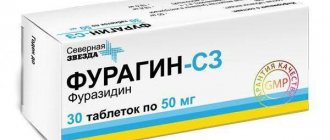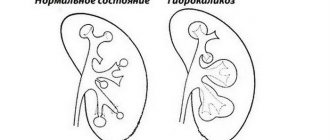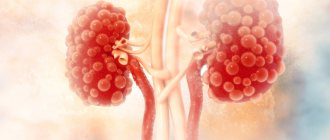A kidney cyst is a benign cavity with dense walls filled with liquid contents. It is located in any part of the organ, has a variety of sizes, is prone to enlargement and suppuration, and often recurs after a therapeutic puncture.
Our expert in this field:
Martirosyan Gurgen Armenovich
Urologist-oncologist, Ph.D.
Call the doctor
The only and absolutely radical way to treat cysts is surgery ; there is no effective drug therapy for cystic pathological changes.
Prevalence of kidney cysts
One of the most common urological pathologies, however, is more typical for older men. The main causes of the disease have not been determined; there is a high probability of initiation of cystic pathology after injury. Hereditary inferiority of the internal epithelial lining of the renal tubules cannot be ruled out, when with a slight increase in the pressure of produced urine, protrusions easily form in the wall, which over time increase and “detach” from the renal tubule.
Clinical diagnosis of kidney pathologies
In most cases, a patient interview and general examination do not reveal any abnormalities; there may be a history of complaints of minor pain. Laboratory tests reveal signs of the presence of a focus of inflammation in the body, changes in the composition of urine (leukocytosis, erythrocytosis, bacteremia, changes in urea and creatinine levels).
The cyst can be seen by ultrasound; if necessary, computed tomography or magnetic resonance imaging is performed. These methods allow us to examine in detail the structure of the tumor (thickening, septum), and detect signs of malignant processes.
With progressive pathology, it is possible to take a sample of cystic tissue for analysis and aspiration of the contents of the bladder.
Based on the examination data, the doctor prescribes symptomatic conservative treatment or recommends removal of the kidney cyst. Drug therapy cannot rid the patient of the cyst, but it fights its negative manifestations: pain, increased blood pressure, and concomitant infections.
Main mistakes in diagnostics
In rare cases, renal cell carcinoma may be disguised as a cyst, forming a decay cavity disproportionately larger than the tumor itself.
Mistaking polycystic degeneration caused by genetic abnormalities for a large simple kidney cyst. Polycystic kidney disease and kidney cysts are treated differently.
Undetected genetic mutations leading to polycystic disease, when severe congenital pathology is interpreted as a banal cystic cavity.
The specific nature of the cystic cavity has not been established - a parasitic or infectious disease.
Refusal of high-tech imaging methods - CT and MRI in favor of ultrasound alone.
The most important role in diagnostics is given to the quality and resolution of the equipment, but everything is useless if the knowledge and experience of the specialist is insufficient; in our clinic we guarantee a balance of technical capabilities and professionalism
Contraindications
The cyst can be located anywhere on the surface of the kidney. Removal of the tumor is prescribed only if it poses a real threat to the patient’s life.
Cases when the doctor cannot operate:
- education does not bother the patient;
- absence of pain;
- poor blood clotting;
- cardiovascular diseases and respiratory tract pathologies;
- acute period of diabetes mellitus.
Like any treatment method, cyst removal has its limitations:
- Severe pathology of the heart and blood vessels.
- Decompensated diabetes mellitus of both types.
- No obvious symptoms.
- The severity of the inflammatory process in the cyst.
- Sensitization of the body.
- ARVI, acute respiratory infections, influenza.
In other words, the operation is performed during the period of remission and when the patient’s condition is satisfactory.
What complications are possible if you refuse surgical treatment?
Find out how to get rid of kidney cyst pain!
- Chronic pain in the lumbar region on the side of the pathology.
- Increased blood pressure when the vascular bundle is compressed by an enlarging cyst.
- Constant or frequent presence of blood in the urine.
- Impaired renal function due to replacement and compression of the organ parenchyma resulting in renal failure.
- The formation of stones due to chronic stagnation of urine in the pelvis when the outflow of the ureter is blocked by a cystic formation.
All of the above conditions can be independent and accompany the ongoing process of cyst enlargement; differential diagnosis will be made possible by timely surgery.
Only surgical treatment will get rid of the cyst and direct the treatment of concomitant diseases towards an adequate modern approach.
We have already saved 1289 kidneys
Take care of yourself, make an appointment with a urologist now.
Folk remedies
When talking about the causes and treatment of kidney sinus cysts, you need to pay attention to alternative medicine recipes. Here are the ones that are considered the most effective:
But the simplest recipe is green tea. You need to dilute it in a 1:1 ratio with milk and drink it with honey twice a day.
Treatment of kidney cyst
The therapeutic approach is determined by the size of the formation and its condition - inflammation or suppuration.
If the diameter of the cyst is less than 3 cm and there are no objective signs of inflammatory changes, a therapeutic puncture is possible with the removal of fluid from the cavity and the subsequent introduction of a sclerosing substance into the capsule. The effect of manipulation is unpredictable, it is influenced by the rate of formation of cystic fluid and the lability of the cyst walls - dense tissues are less likely to stick together. In response to the introduction of a sclerosing agent, the epithelium lining the cyst can increase fluid production, nullifying all efforts.
The only radical treatment method is surgery with excision of the walls of the cystic formation.
The operation is performed open - in the traditional way with a dissection of the abdominal wall in the lumbar region and through several punctures - laparoscopically. There are differences in the duration of the operation; endoscopic intervention takes longer, but the recovery period after it is disproportionately shorter.
The specialists of our clinic guarantee a 100% result of the operation with the complete exclusion of cyst recurrence. The patient is given the right to choose the method of operation, we have high surgical quality
Indications for surgery
Surgical intervention is used in cases where conservative therapy is ineffective
- Pain syndrome that does not go away for a long time. It can be a sharp or dull aching pain;
- Growth of the cavity up to 10 cm or more;
- Pressure and obstruction of a cyst on the kidney to the normal outflow of urine;
- Fluid infection, suppuration, abscess caused by cystosis;
- Atrophy or necrosis of renal tissue and the development of vascular hypertension of the kidney;
- Rupture of the cystic bursa and spillage of the contents into the abdominal cavity;
- Blood in the urine;
- The dynamics of the transformation of a benign tumor into a malignant one, the presence of cancer cells in the cystic fluid.
- Exacerbation of diabetes mellitus;
- Diseases of the cardiovascular and respiratory systems;
- No symptoms of the disease;
- Chronic or acute inflammatory processes in the peak stage;
- Allergic reactions;
- Seasonal diseases.
Important! Practice shows that if the renal cyst already exceeds the size of 3 cm, then sooner or later the patient will be referred for surgery. In most cases, the pathology is supplemented by constant pain, general weakness and other signs of malaise.
Contraindications for surgery:
In order for the surgery to be as successful as possible, the patient must pass all tests
Sometimes it is necessary to remove hair, but some doctors are against this procedure, but it doesn’t hurt to wash yourself thoroughly, as well as to remove the piercing.
- Pain syndrome that does not go away for a long time. It can be a sharp or dull aching pain;
- Growth of the cavity up to 10 cm or more;
- Pressure and obstruction of a cyst on the kidney to the normal outflow of urine;
- Fluid infection, suppuration, abscess caused by cystosis;
- Atrophy or necrosis of renal tissue and the development of vascular hypertension of the kidney;
- Rupture of the cystic bursa and spillage of the contents into the abdominal cavity;
- Blood in the urine;
- The dynamics of the transformation of a benign tumor into a malignant one, the presence of cancer cells in the cystic fluid.
- Avoid taking medications and folk remedies that thin the blood.
- Surgery is stressful for the immune system, so it is important to avoid hypothermia and colds.
- The operation should not be performed in case of cyclic bleeding in women; the optimal time is 7-20 days of the cycle.
- Be sure to pass the required tests: blood, urine, ECG and undergo other prescribed procedures. The statute of limitations for analyzes cannot be later than 28 days. Often, ultrasound and computed tomography are required to determine the dynamics of development.
- The recommended diet must be followed both before and after surgery. As a rule, this is the exclusion of dairy products, some vegetables and fruits. Before the day of surgery, you need to refuse dinner, do an enema, and 8-9 hours before the procedure, do not eat or drink, unless this is prohibited for medical reasons.
An operation to remove a cyst can be performed in several different ways and depends directly on the patient’s condition, as well as test results and the degree of development of the disease.
Before the operation, the patient must stop taking medications that can thin the blood.
Various surgical interventions, even those that do not involve tissue incisions, but only punctures, are a great stress for the body, namely for the human immune system. It is recommended to avoid severe hypothermia, as well as various colds and infections, immediately before going to the hospital.
Blood and urine tests will also need to be done. In addition, you will need to visit a therapist, have an electrocardiogram, and an ultrasound examination of the kidneys. In some rare cases, they resort to the use of CT (computed tomography).
It would be advisable to go on a diet 1-2 days before surgery, which excludes: baked goods, fruits and vegetables. All of these types of foods can cause excess gas. It is recommended to undergo therapeutic fasting for about 12 hours before the planned operation.
After the kidney cyst has been removed, the patient is advised to remain in bed. Soon you will be allowed to stand up, and then you will need to gradually get used to moderate physical activity.
They usually start with a short walk. The rehabilitation period takes about 1.5 months on average.
After these days, you can engage in moderate physical labor and return to your normal lifestyle.
It is also necessary to set strict boundaries in nutrition. In the first 7 days after surgery, it is advisable to adhere to a diet that excludes fatty and fried foods, as well as canned food and spicy foods.
To eliminate pain, the doctor prescribes painkillers. You will also need to undergo a course of antibiotic treatment. It is important to remember that after removal of a cystic formation, you must undergo routine examinations at least 2 times a year.
Based on the physician’s conclusion, the results of blood and urine tests, ultrasound or computed tomography, the doctor prescribes the necessary operation. Before surgery, it is recommended to follow a diet. It is necessary to exclude bread products, vegetables and fruits. It is also better not to eat dinner or drink liquids the night before surgery. Avoid hypothermia or colds.
It is advisable to perform the operation during the absence of menstruation.
- The formation is large (diameter more than 5 cm).
- Rapid growth of the tumor in a short time.
- Suppuration of the cystic bladder.
- Severe renal hypertension.
- Disturbances in the formation and outflow of urine.
- Pathological changes in the composition of urine, the presence of blood in it.
- Recurrent pyelonephritis.
- Pathologies of organ structure, bleeding.
The operation is not always indicated and not for everyone. Surgery is prescribed in the following cases:
- Pain syndrome of a persistent nature, not relieved by conservative treatment methods, or an acute attack of unbearable pain.
- A cavity whose dimensions exceed 10 cm.
- The cyst causes obstructed urine flow.
- Abscessation of a kidney cyst, spread of the pyogenic process.
- Destruction of the kidney parenchyma and its nephrons with severe hypertension.
- Rupture of the cavity and toxic damage to the kidney tissue by its contents.
- Hematuria, determined visually.
- The likelihood of malignancy due to the presence of atypical cells in the cyst.
Nephrologists advise everyone who has been diagnosed with a kidney cyst to decide on surgical intervention in the early stages of cavity development, when its size begins to exceed 3 cm. Small cysts are removed endoscopically and practically do not cause postoperative complications.
Timely removal of a cavitary neoplasm prevents the development of colic and a decrease in the functional capacity of the kidney.
Any method of surgical intervention, including laparoscopic surgery to remove a kidney cyst, requires certain preparation. Typically, a clinical minimum examination of a surgical patient is completed, which consists of passing a CBC, OAM, determining the prothrombin index (PTI), taking an ECG, fluorography, testing for HIV, HIV, hepatitis and examination by a therapist.
Doctors recommend that a week before surgery, try to avoid colds, hypothermia, and communication with flu-infected colleagues and friends, since any decrease in immunity is undesirable. For women, the day of the monthly cycle is also important: from 7 to 20 - the time of absence of bleeding.
The shelf life of the tests does not exceed 14 days. The necessary examination of the kidneys is prescribed by the attending physician: ultrasound, Doppler, CT, MRI and other instrumental research methods.
Three days before surgery, exclude flour, fruits and vegetables from the diet. Before the intervention, they do not eat dinner and do a cleansing enema. 8 hours before surgery - fasting.
Sanitary measures are also carried out: the hair on the abdomen and pubic area is cut short (shaving is not recommended to prevent inflammation of the hair follicles), the skin of these areas is thoroughly treated with soap and Miramistin, and the piercing is removed. Patients with varicose veins are recommended to use compression stockings during surgery (and in the postoperative period).
On the eve of the operation, you should not eat or drink anything.
Rehabilitation should be supervised by a doctor.
A successful operation is half the battle. Rehabilitation after removal of a kidney cyst is of great importance, since if certain recommendations are violated, serious complications may develop.
The patient should remain in bed for 24 hours after the procedure. The next day, short walks around the ward are allowed.
Depending on the progress of recovery, the patient should stay in the hospital for 3-7 days. Within 2 months, rehabilitation is completed and the person can return to their normal lifestyle.
After abdominal surgery, the recovery course is much longer than after other methods of cyst removal. If there are no complications, the patient has to stay in the hospital for about 3 weeks.
Since the surgical intervention left a large wound, it is necessary to constantly apply dressings and monitor the condition of the stitches. The doctor prescribes the use of antibiotics, anti-inflammatory and painkillers.
The rehabilitation period depends on the type of surgery, but on average lasts about a month.
Diet
What complications develop when radical treatment is delayed?
- Rupture of the cystic cavity with the development of a clinical picture of an acute abdomen; in such a situation, surgical intervention is inevitable for health reasons;
- Suppuration of the contents after a common cold resulting in a carbuncle or kidney abscess and sepsis, which will require removal of the entire kidney and long-term treatment;
- Bleeding into the cystic cavity with the development of a picture of an acute disease and, possibly, surgical intervention for emergency indications;
- Functional kidney failure and the development of organ failure followed by hemodialysis.
Forecast
For a simple, benign cyst, the prognosis is 99.9% positive. And it doesn’t matter what kind of treatment tactics will be implemented. If the cyst does not cause dangerous complications (infection, cancer, changes in the kidneys, etc.), then treatment will lead to a complete recovery of the patient.
But even given such positive statistics, this disease should not be ignored. There is always a risk of cyst rupture. Then its contents will end up in the abdominal cavity. And this is fraught with peritonitis - severe and life-threatening inflammation.
How can juniper help?
It so happened that to this day the exact causes of kidney cysts are unknown. Treatment with folk remedies is mainly aimed at stopping the activity of inflammatory foci and maintaining the body’s own defenses. This is exactly the effect that is inherent in products that can be prepared at home using juniper. It is believed that a decoction of parts of this plant allows one to cleanse the body of toxic components, stimulate the excretion of urine, and prevent infectious processes.
For 10 g of dried crushed fruits, a glass of water is needed. Dry raw materials and liquid are mixed in a saucepan, heated and cooked for 7 minutes, maintaining minimal heat. The drug is intended for use in food 4 times daily. Dosage – a couple of tablespoons.
If the disease is severe, it is necessary to use this composition much more often - a portion every couple of hours. Be sure to drink the drug before going to bed. Even if it is not possible to identify the cause of a kidney cyst in a particular case, treatment with folk remedies, as those who practice it assure, shows good results. To increase the effectiveness of the course, you can supplement it with juniper essential oil - it is sold in almost any pharmacy. The dosage and frequency of taking the oil should be agreed with the doctor - selection is carried out individually.
Classification of the disease
Classification of renal tissue cysts:
- Congenital;
- Purchased.
Congenital formations are divided into several types. Depending on their type, doctors determine treatment tactics and the possibility of self-cure of the pathology.
As we have already indicated, kidney cysts can be congenital or acquired according to the nature of their manifestation.
Congenital cystic formations can manifest themselves in the following forms:
- Solitary renal cyst. Such a cyst is also benign; its shape is either round or oval. There are no constrictions, no connections with ducts. There is a serous fluid inside, in some cases there is an admixture in the form of pus or blood. Basically, such a cyst develops only when one kidney is affected, after a previous injury. In approximately half of the cases, this type of cyst is detected simultaneously in several places on the affected kidney. A characteristic feature of this form is that most often it manifests itself as a solitary cyst of the left kidney and is diagnosed in the vast majority of men.
- Multicystic. In this case we are talking about congenital damage to one of the kidneys. This form of pathology is diagnosed very rarely. With the development of a severe form of this type of pathology, the kidney is externally transformed into one continuous cyst, which, due to the scale of the lesion, deprives it of its inherent functions (in other words, the kidney cyst becomes incapacitated). In addition, in some cases, even with this variant of the development of pathology, a small healthy area may remain in the affected kidney, which ensures the production of a small amount of urine that accumulates in the cavities of the cysts.
- Polycystic disease. In this case, both kidneys are affected simultaneously. Due to the multiple formation of cysts, the appearance changes so much that they begin to resemble bunches of grapes. Predominantly genetic predisposition is the main factor provoking the development of polycystic kidney disease.
- Spongy kidney (otherwise known as multicystic medulla). Congenital pathology, accompanied by dilation of the renal tubules with the concomitant formation of multiple small cysts.
- Kidney dermoid cyst (or dermoid). A congenital form of pathology, accompanied by the formation of cysts, inside of which components of the ectoderm are found. Such components can be considered fat, epidermis, bone inclusions, hair, etc.
- Cystic formations in the kidneys caused by concomitant hereditary syndromes (tuberculous sclerosis, Zellweger syndrome, Meckel syndrome, etc.).
As we have already indicated, a kidney cyst can also be an acquired pathology, and in this case it also has its own characteristics. First of all, acquired cystic formations are characterized by the fact that their appearance is preceded by kidney injury or actual renal pathology of one type or another (tuberculosis, parasitic infections, pyelonephritis, glomerulonephritis, heart attack, etc.).
With a general examination of cysts, the reader may notice that kidney damage can be either unilateral or bilateral, which also determines a separate position for them in the general classification.
Depending on the location, a kidney cyst may correspond to the following location options:
- subcapsular kidney cyst - in this case the cyst is located under the fibrous layer of the affected organ;
- intraparenchymal kidney cyst - the cyst is concentrated directly in the parenchyma (organ tissue);
- cortical kidney cyst - the location of the cyst is in the sinus of the organ;
- parapelvic kidney cyst - location of the cyst within the sinus area of the organ.
Depending on the structure of the kidney cyst, the neoplasm can be single-cavitary (solid, single-chamber) or multi-chambered - in this case, the neoplasm has septa.
Postoperative period
For minimally invasive interventions, the patient must stay in a medical facility for 3 days. Complex surgical operations require a recovery period of about 7–10 days, with further sick leave for up to 30 days. To avoid complications, the patient must take painkillers and antimicrobial drugs, including antibiotics, for 1 week.
Meals must be strictly vegetarian, alcoholic and carbonated drinks are completely excluded. A repeat examination is scheduled no earlier than 2 months after surgery.
Preventive actions
Kidney cysts in men and women are a complex disease and treatment can be lengthy and in some cases difficult. But you can avoid the disease if you follow certain rules:
- avoid injuries to the lumbar region;
- in case of kidney injury in the system, conduct an ultrasound examination of the kidney condition;
- avoid excessive physical activity;
- As men age, they should be attentive to their hormonal levels and, in case of disturbances, seek medical help;
- for inflammation in the genitourinary system, treatment should be timely;
- monitor dental health and the condition of the upper respiratory tract. Diseases that are not treated in time can cause inflammatory processes in the kidneys.
Prevention of congenital cysts requires special attention. Therefore, a woman preparing to become a mother should avoid prolonged exposure to direct sunlight, give up smoking and alcohol, and if she has chronic diseases of the genitourinary system, begin treating them before conception.
How to prevent the development of kidney cysts in women? In order not to encounter this rather serious disease, experts strongly recommend promptly treating all ailments, including those of an inflammatory nature. It is important to avoid hypothermia whenever possible and regularly undergo a full diagnostic examination.









